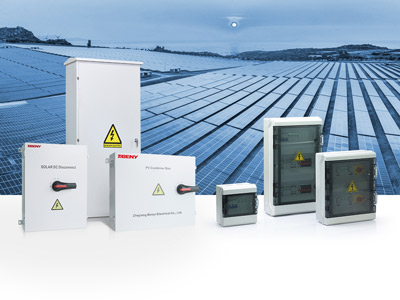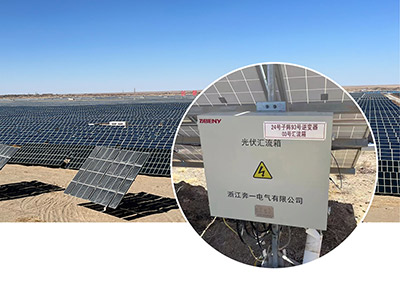Ensuring Safety and Reliability: The Significance of DC Combiner Boxes in Solar PV Systems
With the increasing demand for solar energy, the need for reliable and secure components in photovoltaic (PV) systems is on the rise. One of the key components in this regard is the DC combiner box for solar. But what role does the DC combiner box play in solar systems, and why is it so important?
Basic Information
Photovoltaic power generation is the process of converting sunlight into electricity using semiconductor materials with the photovoltaic effect. A PV array, also known as a solar panel array, consists of multiple solar panels connected together to generate enough electricity to meet the power needs of homes or businesses. In medium to large-scale commercial PV systems, solar panels are often connected in series to form extensive arrays. The DC combiner box (string box) is a wiring device specifically designed for PV systems, primarily responsible for ensuring orderly connection and current consolidation by parallel connecting multiple PV arrays. Through the cooperation of controllers, DC distribution cabinets, inverters, AC distribution cabinets, and other auxiliary equipment, the DC combiner box helps build a complete PV power generation system, enabling it to be grid-connected with the utility.
Typical Components
The design and configuration of solar DC combiner boxes may vary depending on environmental conditions and user requirements, but they all focus on providing safe, durable, and efficient power management. Typical DC combiner boxes consist of several key components, including:
PV Fuses: Usually a combination of fuse holders and fuse cores, they are typically located at the input end. In emergencies such as overcurrent or short circuits, PV fuses disconnect the relevant circuit. If a fuse is blown or melted, it needs to be replaced based on the specific situation.
DC Isolator Switch/Circuit Breaker: Typically located at the output end, it can be used to manually disconnect or isolate circuits.
DC Surge Protective Device: As a critical part of the entire PV system, DC surge protective devices (SPDs) can protect sensitive electrical equipment from the harm of overvoltage, which can lead to a shortened lifespan or even equipment damage.
Busbars: Busbars are multi-point conductive metal strips or rails that connect various current branch circuits in the PV system, serving the purpose of collecting, distributing, and transmitting electrical energy.
Input Terminals: These terminals are used to connect the DC outputs of various solar arrays to the combiner box.
Enclosure: Typically made of materials like PC (Polycarbonate) or ABS (Acrylonitrile Butadiene Styrene), the enclosure of a DC combiner box is designed to meet IP65 standards, providing waterproof, dustproof, and UV-resistant (Ultraviolet) features to withstand harsh environments.
Monitoring System: Some modern combiner boxes are equipped with monitoring functions that can track real-time performance data for each PV array, including current, voltage, etc.

Solar System Integration
DC combiner boxes play a crucial role in PV systems, typically located between the solar panels and the inverters. The primary task of these combiner boxes is to consolidate and series-connect direct currents generated by solar panels into a higher voltage direct current circuit. This integration process reduces the number of wires required to connect solar panels to inverters, simplifying the entire system and ensuring that the inverter receives a consistent and optimal input voltage.
Main Advantages
Enhanced Safety: DC Combiner boxes are equipped with overcurrent protection, surge protection, and other protective functions, ensuring that PV systems are protected against overcurrent, lightning strikes, or voltage fluctuations. Through DC isolator switches, combiner boxes can disconnect the connection to solar panels when needed, ensuring that maintenance personnel are not exposed to direct current hazards.
Improved Efficiency: DC combiner boxes consolidate the direct current outputs of multiple solar arrays, reducing the length of wires and cables used. This helps minimize voltage drop due to wire resistance, thereby improving the efficiency of energy transmission.
Simplified Installation: Current consolidation by DC combiner boxes reduces the number of connections and wires required, simplifying system installation and reducing the likelihood of faults. Additionally, cable management becomes more organized, reducing cable wiring complexity and maintenance difficulties, thereby enhancing system maintainability.
Real-time Monitoring: Some DC combiner boxes come equipped with monitoring systems that can continuously monitor performance data for each PV array, including current and voltage. Maintenance personnel can also promptly identify and resolve faults such as abnormal voltage or current with the problem detection function.

BENY’s Innovative Solutions
As DC combiner boxes operate in high-voltage environments for extended periods, stringent safety requirements are imposed on them. BENY combiner boxes of 1000V and 1500V are equipped with multiple protection functions to comprehensively ensure system safety. Firstly, the combiner box is equipped with fuses that provide short-circuit and overcurrent protection. When the current exceeds the specified value and persists for a certain period, the fuse melts due to the heat it generates, rapidly disconnecting the circuit to ensure that the system remains undamaged. Secondly, surge protective devices are equipped to divert current leakage caused by factors such as lightning to the ground, preventing damage from transient overvoltage. These protective measures effectively reduce the risk of the system being impacted by external voltage surges. Additionally, customers can choose between circuit breakers and DC isolator switches based on their requirements, further enhancing system security.
BENY provides services of DC combiner box customizations , allowing customers to select single or multiple current inputs and outputs based on their needs and system installation requirements. They can also opt for diodes to prevent current backflow and install monitoring system to enable real-time monitoring of current and voltage data. In the event of abnormal voltage or current, personnel can promptly identify and resolve faults, ensuring the system operates smoothly.
Considering that DC combiner boxes are typically installed in harsh environments, BENY offers options for UV-resistant plastic enclosures and iron enclosures. These enclosures meet IP65 protection and IK10 explosion-proof standards, enabling them to withstand the impact of adverse conditions and operate normally within a temperature range of -25°C to +60°C. BENY's products have obtained certifications from authoritative organizations such as TUV, UL, CE, and comply with international quality standards, making them industry-leading.
DC combiner boxes play an indispensable role in PV systems, providing critical safeguards for system installation and operation. As a leading industry manufacturer, BENY will continue its commitment to technological innovation and provide customers with secure and reliable DC power transmission and distribution solutions, advancing towards greater intelligence, enhanced monitoring and diagnostic capabilities, and higher safety performance.





